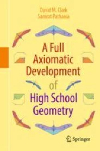- About MAA
- Membership
- MAA Publications
- Periodicals
- Blogs
- MAA Book Series
- MAA Press (an imprint of the AMS)
- MAA Notes
- MAA Reviews
- Mathematical Communication
- Information for Libraries
- Author Resources
- Advertise with MAA
- Meetings
- Competitions
- Programs
- Communities
- MAA Sections
- SIGMAA
- MAA Connect
- Students
- MAA Awards
- Awards Booklets
- Writing Awards
- Teaching Awards
- Service Awards
- Research Awards
- Lecture Awards
- Putnam Competition Individual and Team Winners
- D. E. Shaw Group AMC 8 Awards & Certificates
- Maryam Mirzakhani AMC 10 A Awards & Certificates
- Two Sigma AMC 10 B Awards & Certificates
- Jane Street AMC 12 A Awards & Certificates
- Akamai AMC 12 B Awards & Certificates
- High School Teachers
- News
You are here
A Full Axiomatic Development of High School Geometry

Publisher:
Springer
Publication Date:
2023
Number of Pages:
148
Format:
Hardcover
Price:
59.99
ISBN:
978-3031235245
Category:
Textbook
[Reviewed by , on ]
Frederic Morneau-Guérin
07/15/2023
The book A Full Axiomatic Development of High School Geometry focuses on the top tier in a sequence of four educational tiers of geometry beginning in preschool and primary grades, where young children gain their first experiences with abstract shapes through definitions and an assortment of geometry facts. In the second tier, which is high school, students are expected to understand these facts and the definitions associated with them, then use them to solve problems and form logical arguments to establish other facts. At the third tier, normally through a one-semester geometry course, future teachers in training are expected to understand the source and origin of the facts they will be teaching their own students and to understand how truth is established in this subject by using mathematical proofs.
The authors, David M. Clark and Samrat Pathania, estimate (and it makes sense) that to ensure the reliability and credibility of geometry from kindergarten to grade 12, it is imperative to be able to count on a certain number of people who have a full understanding of the subject. By this, they mean people who know and understand the source and genesis of the standard content of secondary school Euclidean geometry, without unstated assumptions or any other logical compromises. By proposing a comprehensive axiomatic development of standard secondary geometry topics, the authors hope to help anchor K-12 geometry directly in sound modern mathematics by providing a fundamental knowledge base that will strengthen secondary and tertiary geometry education by promoting deeper understanding.
Chapters 1 to 7 of the book consider a plane as a set of points whose only primitive construct is a function that formalizes the intuitive idea of distance between two points. Ten simple Hilbert-style axioms of geometry are stated and used to coherently and incrementally introduce a wide range of results that can be deduced from these axioms (deduction, however, is left for the reader to work out). This set of results includes nearly all the geometric facts mentioned in the standard secondary school curriculum. Among the carefully defined concepts whose properties are demonstrated in the form of theorems are length, area and angle measures, congruence, and similarity.
The eighth and final chapter is an exception. Two metamathematical questions are raised here: (1) is there really a plane that is a model of the ten axioms mentioned above? (2) If so, exactly which planes are models of these axioms? The author offers an answer to both these questions, based on Millman and Parker's book titled Geometry: A Metric Approach with Models.
Because of its subject, this book is likely to be of interest to many future secondary mathematics teachers in training. However, due to the pedagogical approach used (inquiry with minimal discrete guidance) but also the notational heaviness and density of the information presented (250 results in just 115 pages, punctuated by 90 figures), this book is unlikely to be suitable for anyone other than undergraduate students of pure mathematics who are at the end of their studies and want to learn more about the foundations of classical geometry. It is somehow disappointing that the authors have been so sparing with explanatory remarks, since the introductory comments at the start of each chapter show how deftly they can help the reader to develop and consolidate metacognitive skills, such as recognizing implicit uses of results or properties in certain demonstrations.
Frederic Morneau-Guérin is a professor in the Department of Education at Université TELUQ. He holds a Ph.D. in abstract harmonic analysis.
See the publisher's website.
- Log in to post comments




